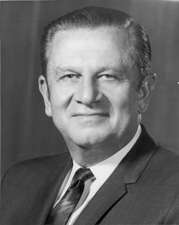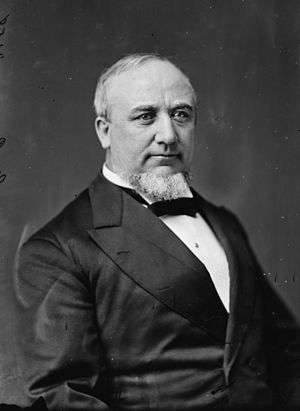Howard Cannon
| Howard Cannon | |
|---|---|
 | |
| United States Senator from Nevada | |
|
In office January 3, 1959 – January 3, 1983 | |
| Preceded by | George W. Malone |
| Succeeded by | Chic Hecht |
| Personal details | |
| Born |
Howard Walter Cannon January 26, 1912 St. George, Utah, U.S. |
| Died |
March 5, 2002 (aged 90) Las Vegas, Nevada, U.S. |
| Political party | Democratic |
| Spouse(s) | Dorothy Pace Cannon |
| Children | 2 |
| Profession | Attorney |
Howard Walter Cannon (January 26, 1912 – March 5, 2002) was an American politician. He served as a United States senator from Nevada from 1959 until 1983 as a member of the Democratic Party.
Early life and education
Cannon was born in Saint George, Utah. His grandfather David Cannon, was the younger brother of George Q. Cannon, and a leading figure in the building of the St. George Temple, who was later the third president of that temple. His father Walter Cannon was one of David Cannon's 31 children. Howard's parents had married in 1909, his mother was Leah Sullivan. When Cannon was two years old his father left for England to served a mission for The Church of Jesus Christ of Latter-day Saints for two years.[1]
Cannon went to Woodward School in St. George, close enough to his home he could walk home for lunch. He then went to Dixie High School. During summers, he worked as a Bell Hop at the North Rim Lodge along the Grand Canyon. In the evenings he would form a small band where he used his skills as a saxophonist to entertain guests. He delivered copies of the Deseret News around St. George on horseback.[2]
He graduated from Dixie Junior College, and received a bachelor's degree in music education from Arizona State Teachers College (now Northern Arizona University) in 1933. He then received an LL.B. degree from the University of Arizona Law School (1937).[3] While studying at the University of Arizona he was the director of the university pep orchestra. Between the summer of his second and third year he directed this group at a hotel in Seattle, Washington. In the summer of 1936 after his graduation he directed an orchestra of four, performing on the SS Jefferson on a cruise from Seattle, Washington to Yokohama, Japan. Also during his law school years Cannon competed in rodeos and learned to be an airplane pilot.
Also in the summer of 1936, Cannon began dating Dorothy Pace of Alamo, Nevada. She went to Los Angeles, California to study at the Sawyer School of Business and then worked as a secretary there in her uncle's company. Their relationship did not progress much at this time. For the next few years Cannon dated Carma Fawcett who was killed in a car accident in 1940.
After he finished law school he returned to St. George. Among his actions on his return was buying a house adjacent to Dixie College as an investment property.
Early career
Cannon became a lawyer after passing the bar exams in Arizona (1937), Utah (1938) and Nevada (1946). He served as a reference and research attorney for the Utah State Senate in 1939, and won election as County Attorney of Washington County, Utah in 1940.
Military service
During World War II, Cannon served as a troop carrier pilot in the United States Army Air Corps and its subsequent incarnation as the United States Army Air Forces. Assigned to the European theater, he dropped paratroopers at Saint-Come-du-Mont, Normandy and during the following combat mission in September 1944 was shot down over the Netherlands. He spent 42 days trying to return to the Allied lines with the assistance of the Dutch underground. Released from active duty in 1946, he joined the Army Air Forces Reserve until 1947 when he transitioned to the Air Force Reserve concurrent with the establishment of the U.S. Air Force as a separate service. Continuing to fly in the Air Force Reserve, he achieved command pilot status and ultimately retired from the Air Force Reserve with the rank of major general. His military decorations included the Silver Star, Legion of Merit, Distinguished Flying Cross, the Purple Heart and the Air Medal (three awards).[4]
Continued career
In 1946 Cannon established law offices in Las Vegas. In 1949 he was elected Las Vegas City Attorney, and he served until 1958. In 1958 he won election to the U.S. Senate after defeating incumbent George Malone by a wide margin. He won reelection in 1964, 1970, and 1976.[5]
U.S. Senate
Elections
In 1956, Cannon ran for the U.S. House of Representatives to succeed Republican incumbent C. Clifton Young, who ran for the U.S. Senate, but lost the Democratic primary to former Congressman Walter Baring, who then won the general election. In 1958, he was elected to the United States senate, unseating Republican Senator George W. Malone with 58% of the vote. Cannon was nearly defeated in his first re-election bid in 1964, holding off Republican Lieutenant Governor Paul Laxalt in one of the closest Senate elections ever. On election night, one of the networks actually projected that Cannon had lost, but several precincts didn't report in until the next morning and gave Cannon enough votes to secure a second term. Ultimately, Cannon only won by 48 votes. He likely would not have won had it not been for Lyndon Johnson's presence atop the ticket; Johnson easily carried the state as part of his 44-state landslide that year. Cannon was re-elected with far less difficulty in 1970, defeating then Washoe County District Attorney William Raggio. He also won re-election easily over former Congressman David Towell in 1976.
In the early 1980s, Cannon was ensnared in a scandal when Teamsters President Roy L. Williams was indicted by federal prosecutors for attempting to bribe Cannon in exchange for using his influence to block a bill deregulating the trucking industry. He testified that he did not know Williams or his associates and denied being offered a bribe, but other witnesses corroborated the story and Williams was convicted. Cannon was challenged in the 1982 Democratic primary by U.S. Representative Jim Santini, winning by about 4,500 votes, but lost the general election to Republican nominee Chic Hecht, a former state senator and businessman.[6]
Tenure

In 1964 Cannon voted for the Civil Rights Act. In the Senate, he was known as a moderate in the Democratic Party. In 1981, he was the recipient of the Tony Jannus Award for his distinguished contributions to commercial aviation. Cannon retired from politics and died in Las Vegas in 2002 at the age of 90. Senator Cannon was also in attendance at the final performance of Diana Ross and the Supremes in January 1970.
Committee assignments
He had an interest in the rules and administration of the Congress, serving as chairman of several committees on that subject, including the rules committee and the inaugural arrangements committee.
Honors
- The passenger terminal at Reno-Tahoe International Airport is named after him.
- The Cannon Center for Survey Research is named after him.[7]
- The Howard W. Cannon Aviation Museum, located in Las Vegas's McCarran International Airport, is also named after him.[8]
References
- ↑ biography of Howard Cannon
- ↑ bio of Cannon
- ↑ "Howard W. Cannon". Las Vegas Review-Journal, K. J. Evans, February 7, 1999
- ↑ http://www.arlingtoncemetery.net/hwcannon.htm
- ↑ The Silver State Nevada's Heritage Reinterpreted byt James W. Hulse
- ↑ Stout, David (7 March 2002). "Howard Cannon, 90, Senator Who Served Four Terms, Dies". New York Times. Retrieved 7 October 2014.
- ↑
- ↑ "Cannon Aviation Museum". Clark County Nevada website
External links
- United States Congress. "Howard Cannon (id: C000120)". Biographical Directory of the United States Congress.
| U.S. Senate | ||
|---|---|---|
| Preceded by George W. Malone |
U.S. Senator (Class 1) from Nevada 1959–1983 Served alongside: Alan Bible, Paul Laxalt |
Succeeded by Chic Hecht |
| Political offices | ||
| Preceded by B. Everett Jordan North Carolina |
Chairman of the Senate Rules Committee 1973–1978 |
Succeeded by Claiborne Pell Rhode Island |
| Preceded by Warren Magnuson Washington |
Chairman of the Senate Commerce, Science and Transportation Committee 1978–1981 |
Succeeded by Bob Packwood Oregon |

